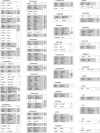A consensus linkage map of the chicken genome
- PMID: 10645958
- PMCID: PMC310508
- DOI: 10.1101/gr.10.1.137
A consensus linkage map of the chicken genome
Abstract
A consensus linkage map has been developed in the chicken that combines all of the genotyping data from the three available chicken mapping populations. Genotyping data were contributed by the laboratories that have been using the East Lansing and Compton reference populations and from the Animal Breeding and Genetics Group of the Wageningen University using the Wageningen/Euribrid population. The resulting linkage map of the chicken genome contains 1889 loci. A framework map is presented that contains 480 loci ordered on 50 linkage groups. Framework loci are defined as loci whose order relative to one another is supported by odds greater then 3. The possible positions of the remaining 1409 loci are indicated relative to these framework loci. The total map spans 3800 cM, which is considerably larger than previous estimates for the chicken genome. Furthermore, although the physical size of the chicken genome is threefold smaller then that of mammals, its genetic map is comparable in size to that of most mammals. The map contains 350 markers within expressed sequences, 235 of which represent identified genes or sequences that have significant sequence identity to known genes. This improves the contribution of the chicken linkage map to comparative gene mapping considerably and clearly shows the conservation of large syntenic regions between the human and chicken genomes. The compact physical size of the chicken genome, combined with the large size of its genetic map and the observed degree of conserved synteny, makes the chicken a valuable model organism in the genomics as well as the postgenomics era. The linkage maps, the two-point lod scores, and additional information about the loci are available at web sites in Wageningen (http://www.zod.wau.nl/vf/ research/chicken/frame_chicken.html) and East Lansing (http://poultry.mph.msu.edu/).
Figures





References
-
- Andersson L, Archibald A, Ashburner M, Audun S, Barendse W, Bitgood J, Bottema C, Broad T, Brown S, Burt D, et al. Comparative genome organization of vertebrates. The First International Workshop on Comparative Genome Organization. Mamm Genome. 1996;7:717–734. - PubMed
-
- Angrist M. Less is more: Compact genomes pay dividends. Genome Res. 1998;8:683–685. - PubMed
-
- Bloom S E, Delaney M E, Muscarella D E. Constant and variable features of avian chromosomes. In: Etches RJ, Gibbins AMV, editors. Manipulation of the avian genome. Boca Raton, FL: CRC Press; 1993. pp. 39–60.
-
- Bumstead N, Palyga J. A preliminary linkage map of the chicken genome. Genomics. 1992;13:690–697. - PubMed
-
- Burt DW, Bruley C, Dunn IC, Jones CT, Ramage A, Law AS, Morrice DR, Paton IR, Smith J, Windsor D, Sazanov A, Fries R, Waddington D. The dynamics of chromosome evolution in birds and mammals. Nature. 1999;402:411–413. - PubMed
Publication types
MeSH terms
Substances
LinkOut - more resources
Full Text Sources
